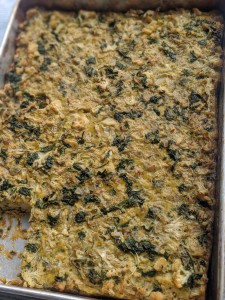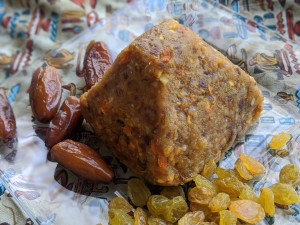The Lilith Blog 1 of 5
April 6, 2020 Susan Barocas
Passover Treats from a Chef and Fridge Forager
Passover is the ultimate food holiday, from the essential symbolism of foods on the Seder plate to what we eat and don’t eat for these exceptional eight days of the year. And then there’s the fact that this is not a go-to-synagogue holiday, but observance takes place at a meal, imbuing our tables themselves with holiness.
During these last few days before the first Seder, Jews – mostly Jewish women, if we’re honest – from all levels of religious observance are usually making final tweaks to menus for the Seders and the rest of the week. The cooking is gaining speed and intensity, too, in preparation for the typically large gatherings of relatives, friends and even strangers who will come together to re-tell and celebrate the story of the liberation journey of the ancient Israelites.
But this year, as we are all too aware, is quite different.The reason for the holiday is, of course, the same as ever. We just have to go about it completely differently than we ever could have imagined. Instead of large gatherings, often with too many people squished into too small a space, we’ve got space with few people. Some of us are alone. Many of us are learning how to share Seders virtually. And when it comes to food, there are some very real challenges.
As we try to create special meals with what we have on hand, supplemented by few, if any, trips the grocery store, it might mean no traditional brisket, chicken soup with matzah balls or other Passover favorites. Horseradish or fresh parsley? Out of the question for many. Matzah meal, matzah ball mix, cake meal, potato starch, even matzah itself…all can be in short supply even if you do venture out.So, what are we to do? When it comes to Passover 2020, we can start by thinking of it as a kind of contemporary foraging in our refrigerators, freezers and pantries, a sort of continuation of the efforts of our foremothers. Throughout history, women have foraged for fruit, nuts, honey, edible plants and herbs to eat and to make healing medicines. Because of this ability to forage and use what they found, women have quietly kept alive not just families, but whole tribes and communities.
In that spirit, let’s dedicate ourselves to doing the best with what we have. How, you ask? Here are a few ideas and tips to help make this a Passover to remember and not just because of the Coronavirus.
Along with the comfort of traditional dishes, embrace this new and different Passover with new tastes from different Jewish traditions around the world. If you don’t want to take too big a plunge, haroset is an easy place to start. In addition to trying new recipes, you can create a haroset bar. Put out whatever fresh and dried fruits, nuts and seeds along with some cinnamon, perhaps allspice and cardamom, sugar, grape juice or wine you have and let each person make their own haroset mixture. Then have a taste-off to choose the favorite. You might even decide to include the winner in your Seder next year.Since few of us have had the opportunity to cruise the aisles of kosher-for-Passover processed and packaged foods, we can focus on eating healthier this year. Cook real food from scratch. Make it easier on yourself and cook enough to have leftovers.
If you are comfortable, go the Sephardic way and eat kitnyot such as legumes, corn and rice, expanding the Passover possibilities.
Get everyone who is locked down with you involved in cooking and use technology to connect you to family and friends, so you can cook “together.” Share recipes before the Seders and throughout the week with your fellow virtual chefs and everyone at your virtual Seder table, so you are all eating one or more dishes alike.
Use alternatives for the Seder plate. No horseradish? Try other food with “bite” such as lemons, hot peppers or, as some Sephardim do, use escarole or endive. Instead of missing parsley, romaine lettuce, celery or even a piece of raw potato can work. Make up new items to put on the seder plate – just as the olive for peace and the orange for inclusivity in Judaism have been added over the past several years, you can add items with meaning to those gathered, letting people know to be prepared to offer their choices virtually.
In the end, we need to be gentle, less demanding of ourselves. The more we can use what we have and be flexible, adaptable and a bit creative, the more food can help us find the meaning and joy in this most unusual holiday celebration and, most importantly, to connect to each other in new, special and memorable ways.
Cauliflower Kuku
 This egg-based dish is a favorite in Persian cuisine. It’s similar to a frittata or omelet, but with more vegetables and herbs and less egg. It can be the center of a vegetarian meal, a side dish or even appetizers cut into small bites. It’s an easy dish to adapt. Chop and sauté whatever vegetables you have at hand – such as broccoli, spinach, carrots, or potatoes. You can also vary the kinds and quantities of herbs, using dried if necessary. This recipe can easily be cut in half and baked in a 9×9 pan. The cooked kuku can be refrigerated for up to five days or frozen up to a month. To serve, defrost if needed and heat in a 350-degree oven, covered for the first 10 minutes, then uncovered, for another 10 to 15 minutes or until heated through.
This egg-based dish is a favorite in Persian cuisine. It’s similar to a frittata or omelet, but with more vegetables and herbs and less egg. It can be the center of a vegetarian meal, a side dish or even appetizers cut into small bites. It’s an easy dish to adapt. Chop and sauté whatever vegetables you have at hand – such as broccoli, spinach, carrots, or potatoes. You can also vary the kinds and quantities of herbs, using dried if necessary. This recipe can easily be cut in half and baked in a 9×9 pan. The cooked kuku can be refrigerated for up to five days or frozen up to a month. To serve, defrost if needed and heat in a 350-degree oven, covered for the first 10 minutes, then uncovered, for another 10 to 15 minutes or until heated through.
- 2 medium yellow onions, diced (about 3 to 4 cups)
- 2 medium heads cauliflower (about 4 to 4 1/2 pounds)
- 2 cups chopped mixed fresh herbs such as parsley, basil, dill or cilantro (about 2 to 3 ounces)
- 1/4 cup extra-virgin olive oil
- 4 cloves garlic, finely minced
- 2 teaspoons ground cumin
- 1 teaspoon sea salt, or to taste
- 1/2 teaspoon freshly ground black pepper or to taste
- 8 large eggs
- 1 cup crumbled feta (about 5 ounces) or shredded parmesan (about 3 ounces) (optional)
Place the oven rack in the middle and preheat to 350 degrees.
Wash the cauliflower and pat dry. Cut the head in half from top to bottom, then cut the florets away from the core and coarsely chop the florets. Dice small any stems attached to the florets as well as the entire core.
Wash and fully dry the herbs. Except for the basil, pick each from large stems and chop, including the small stems, small but not too fine. Chiffonade the basil, cutting it into long, thin ribbons.
In a large skillet over medium heat, add 3 tablespoons oil over medium heat and heat until shimmering. Add the onion and cook, stirring occasionally, until the onion becomes soft and translucent but not browned, 10 to 12 minutes. Add the garlic and cumin, stirring until fragrant, about 1 minute. Add the chopped cauliflower and mix to combine. Cook, stirring occasionally, until cauliflower is softened to al dente, about 10 minutes. Remove the pan from the heat. Add the salt, pepper and chopped herbs and mix well.
In a large bowl, whisk the eggs until just starting to foam. Add the cauliflower mixture and cheese, if using, and mix well.
Swirl 1 tablespoon oil in 9-1/2-by-13-1/2-inch glass baking dish, then place it in the hot oven for 3 to 4 minutes. Heating the pan with the oil helps create a crust on the bottom and sides of the casserole.
Remove the hot baking dish from the oven. Working quickly, pour in the cauliflower mixture and spread it out patting the top smooth. Lightly brush the top with the remaining 1 tablespoon oil. Bake, uncovered, for about 45 minutes, or until the center is firm and the edges golden brown.
Let cool for about 10 minutes before cutting, if serving immediately. Serve warm or at room temperature. Serves 8-10 as a main dish, 12-15 as a side
Nut-Free Turkish Haroset
 A super quick, easy and tasty mixture, this haroset can be made with other dried fruits you have on hand. Most important is to use the orange in balance with two cups of dried fruit.
A super quick, easy and tasty mixture, this haroset can be made with other dried fruits you have on hand. Most important is to use the orange in balance with two cups of dried fruit.
- 1 large orange
- 1 cup golden raisins
- 1 cup pitted dates (14-18)
- Granulated sugar, to taste (optional)
Wash the orange under cool water using dish soap or a vegetable cleaning solution, then rinse thoroughly. Cut off the peel and pith from the two ends of the orange, then cut the whole fruit, peel and all, into eight chunks. Discard any seeds. Place the orange pieces, raisins and dates into the bowl of a food processor with the metal blade and process until you get a chunky paste or a smoother, jam-like consistency, if you prefer. Stop the motor and scrape down the sides of the bowl a few times. Add a little sugar, if desired. Transfer the haroset to a container with a lid and refrigerate until needed, up to two weeks. The haroset is best when made at least 1 day in advance. Makes about 2 cups.
Susan Barocas is a writer, chef, cooking instructor and speaker who served as guest chef for three Obama White House Seders.
 Please wait...
Please wait...